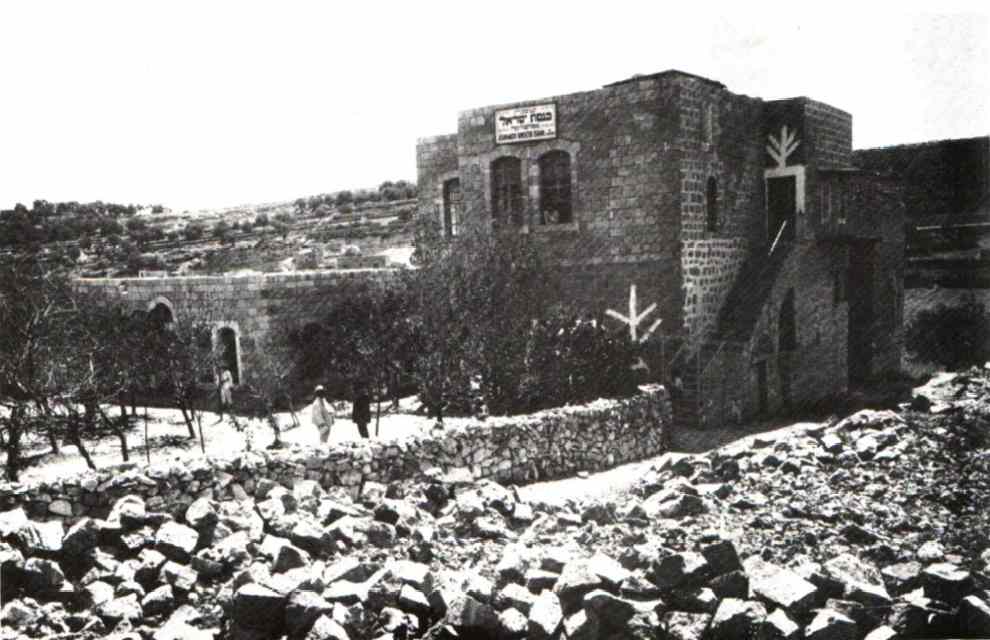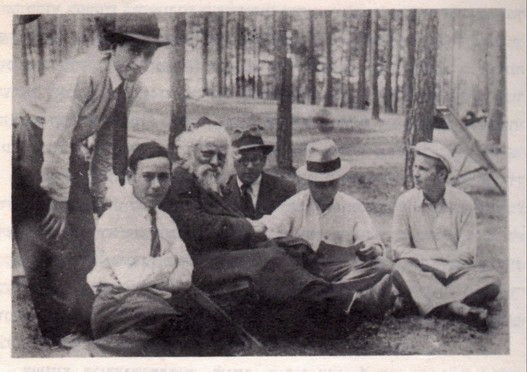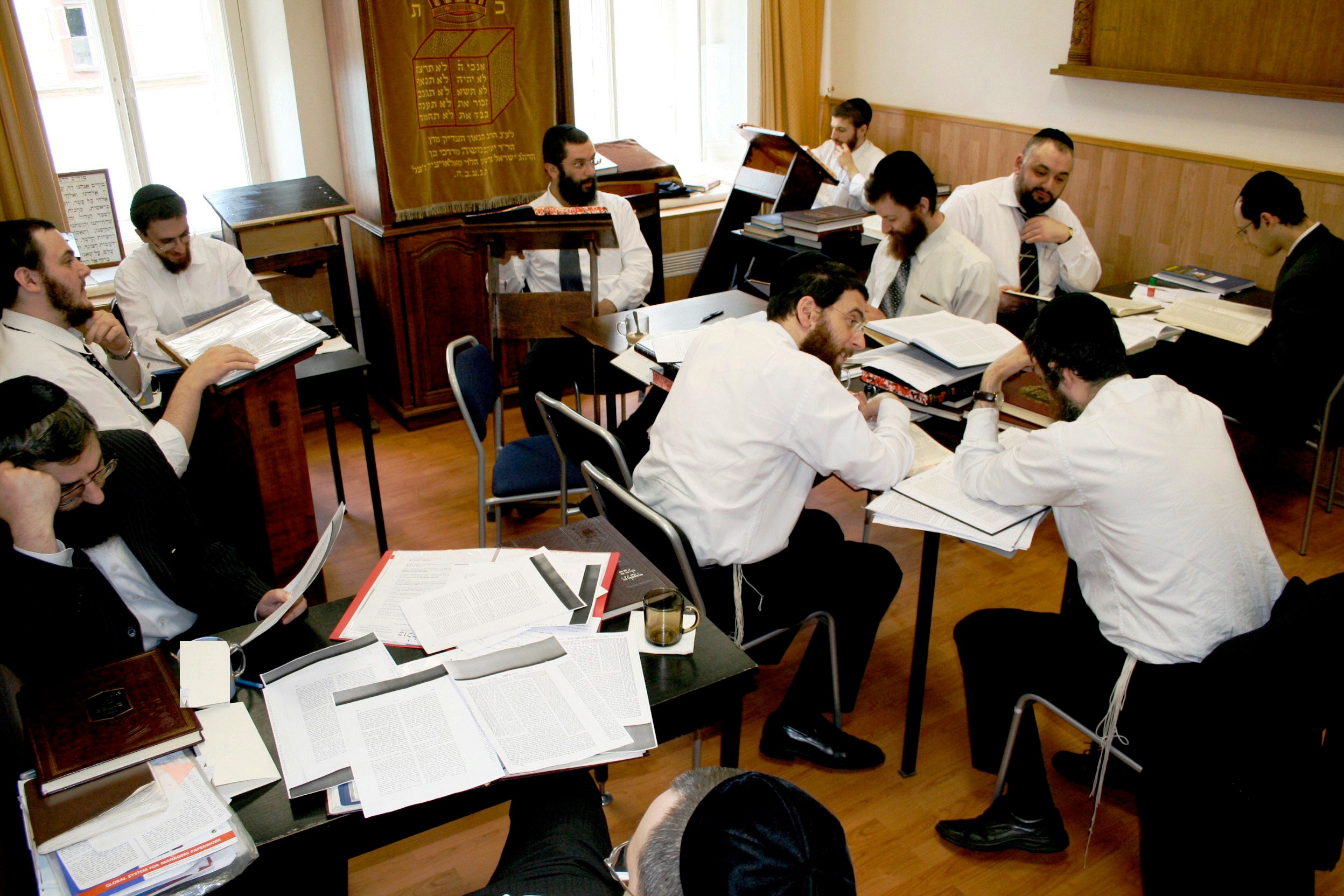|
Shneur Kotler
Yosef Chaim Shneur Kotler (1918 – 24 June 1982) was an Orthodox rabbi and rosh yeshiva of Beth Medrash Govoha (also known as the Lakewood Yeshiva) in Lakewood, New Jersey from 1962 to 1982. During his tenure, he developed the Lithuanian-style, Haredi but non- Hasidic yeshiva into the largest post-graduate Torah institution in the world. He also established Lakewood-style kollels in 30 cities, and pioneered the establishment of community kollels in which Torah scholars study during the morning and afternoon hours and engage in community outreach during the evenings. Upon his death, he had served as the Lakewood rosh yeshiva for exactly the same amount of time as had his father, Rabbi Aharon Kotler, the founding rosh yeshiva of Beth Medrash Govoha: nineteen years, seven months, and one day. Early life He was born in Slutsk, Russia, to Rabbi Aharon Kotler and his wife, Rivka Chana Perel, the daughter of Rabbi Isser Zalman Meltzer. Of his parents' children, only he and his siste ... [...More Info...] [...Related Items...] OR: [Wikipedia] [Google] [Baidu] |
Hebron Yeshiva
Hebron Yeshiva, also known as ''Yeshivas Hevron'', or Knesses Yisroel, is a yeshiva devoted to high-level study of the Talmud. It originated in 1924 when the roshei yeshiva and 150 students of the Slabodka Yeshiva, known colloquially as the "mother of yeshivas", relocated to Hebron. Relocation of Slabodka Yeshiva to Palestine A 1924 edict requiring enlistment in the military or supplementary secular studies in the yeshiva led a large number of students in the Slabodka yeshiva to relocate to the Land of Israel, at that time Palestine under the British mandate. Rabbi Nosson Tzvi Finkel, also known as "Der Alter fun Slabodka" (''The Elder of Slabodka''), sent Rabbi Avraham Grodzinski to head this group and establish the yeshiva in Hebron. Upon Grodzinski's return to Slabodka, the Alter transferred the ''mashgiach ruchani'' responsibilities to him, and the ''rosh yeshiva'' duties to Rabbi Yitzchok Isaac Sher, and he moved to Hebron to lead the yeshiva there together with Rabbi Mosh ... [...More Info...] [...Related Items...] OR: [Wikipedia] [Google] [Baidu] |
Beth Medrash Govoha
Beth Medrash Govoha ( he, בית מדרש גבוה, Sephardi pronunciation: ''Beth Midrash Gavoha''. lit: "High House of Learning"; also known as Lakewood Yeshiva or BMG) is a Haredi Judaism, Haredi Jewish Misnagdim, Lithuanian ''yeshiva'' in Lakewood Township, New Jersey. It was founded by Rabbi Aaron Kotler in 1943 and is the second-largest yeshiva in the world, after Mir Yeshiva (Jerusalem), Mir Yeshiva in Jerusalem. As of 2019, it had 6,715 students, 2,748 regular and 3,967 in Kollel status.https://www.state.nj.us/highereducation/documents/pdf/statistics/fiscal/Enr2018.pdf The principal Rosh yeshiva since 1982 is Rabbi Malkiel Kotler. Talmud and ''halakha'' studies in the institution are carried in the form of over 200 small groups, ''Chaburos'', which consist of several students mentored by a veteran, each pursuing its own specific curriculum with an emphasis on individual learning.Besser, Yisroel. "Child of the Yeshiva". ''Mishpacha'', November 14, 2012, p. 64. History Be ... [...More Info...] [...Related Items...] OR: [Wikipedia] [Google] [Baidu] |
Kaminetz Yeshiva
Yeshivas Knesses Beis Yitzchak was an Orthodox Jewish yeshiva, founded in Slabodka on the outskirts of Kaunas, Lithuania (then ruled by the Russian Empire), in 1897. The yeshiva later moved to Kamyenyets, then part of Poland, and currently in Belarus, and is therefore often referred to as the Kaminetz Yeshiva or simply Kaminetz. The yeshiva was famously led by Rabbi Boruch Ber Leibowitz. Early Years Founding Originally, Slabodka boasted the famous Knesses Yisrael yeshiva, founded by Rabbi Nosson Tzvi Finkel in 1882. However, in 1897, controversy broke out in the yeshiva, as many of the students were opposed to the yeshiva strong focus on mussar (Jewish ethics), as opposed to only studying Talmud. The yeshiva therefore split into two, with the one against mussar going under the name ''Knesses Beis Yitzchok'' (named for the previous rabbi of Kaunas, Rabbi Yitzchak Elchanan Spektor). The rav of Slabodka, Rabbi Moshe Danishevsky, served as ''rosh yeshiva''. Rabbi Moshe Mordecha ... [...More Info...] [...Related Items...] OR: [Wikipedia] [Google] [Baidu] |
Isser Zalman Meltzer
Isser Zalman Meltzer ( he, איסר זלמן מלצר) (February 6, 1870 – November 17, 1953),Isser Zalman Meltzer "Even HaEzel" (1870 - 1953) was a famous Lithuanian Jewish and Belarusian Orthodox rabbi, rosh yeshiva and posek. He is also known as the "Even HaEzel"—the title of his commentary on Rambam's ''Mishneh Torah''. Early life Rabbi Meltzer was born on 5 Adar 5630 (February 6, 1870) in the city of Mir, in the Minsk Governorate of the Russian Empire (present-day Republic of Belarus) to Rabbi Baruch Peretz and Miriam Reisel Meltzer. From the age of 10, he studied with Rabbi Yom-Tov Lipman, the rabbi of the city, and at the Mir Yeshiva. In 1884, at the age of 14, he began studying at the Volozhin yeshiva under the Netziv and Rabbi Chaim Soloveitchik, where he remained for seven years. While at the yeshiva, he became involved in the secret rthodoxNess Ziona Society, part of the Hovevei Zion movement. Together with his brother-in-law, Rabbi Moshe Mordechai Epstein, he c ... [...More Info...] [...Related Items...] OR: [Wikipedia] [Google] [Baidu] |
Orthodox Jewish Outreach
Orthodox Jewish outreach, often referred to as ''Kiruv'' or ''Qiruv'' ( he, קירוב "bringing close"), is the collective work or movement of Orthodox Judaism that reaches out to non-observant Jews to encourage belief in God and life according to Orthodox Jewish law. The process of a Jew becoming more observant of Orthodox Judaism is called ''teshuva'' ("return" in Hebrew) making the "returnee" a ''baal teshuva'' ("master of return"). Orthodox Jewish outreach has worked to enhance the rise of the baal teshuva movement. Varieties Hasidic Hasidic outreach is predominantly the area of the Chabad and Breslov Hasidic groups; however, other groups have also been involved in such efforts. Rabbi Yosef Yitzchok Schneersohn, Sixth leader of the Chabad-Lubavitch branch of Hasidic Judaism, and then his successor, Rabbi Menachem Mendel Schneerson were responsible for turning Chabad's activities toward outreach. Each in turn sent out rabbinic emissaries, known as " Shluchim", and thei ... [...More Info...] [...Related Items...] OR: [Wikipedia] [Google] [Baidu] |
Kollel
A kollel ( he, כולל, , , a "gathering" or "collection" f scholars is an institute for full-time, advanced study of the Talmud and rabbinic literature. Like a yeshiva, a kollel features shiurim (lectures) and learning ''sedarim'' (sessions); unlike most yeshivot, the student body of a kollel typically consists mostly of married men. A kollel generally pays a regular monthly stipend to its members. History Original sense Originally, the word was used in the sense of "community". Each group of European Jews settling in Israel established their own community with their own support system. Each community was referred to as the "kollel of " to identify the specific community of the Old Yishuv. The overwhelming majority of these Jews were scholars who left their homelands to devote themselves to study Torah and serve God for the rest of their lives. The kollel was the umbrella organization for all their needs. The first examples were Kolel Perushim (students of the Vilna Gaon who ... [...More Info...] [...Related Items...] OR: [Wikipedia] [Google] [Baidu] |
Kollel
A kollel ( he, כולל, , , a "gathering" or "collection" f scholars is an institute for full-time, advanced study of the Talmud and rabbinic literature. Like a yeshiva, a kollel features shiurim (lectures) and learning ''sedarim'' (sessions); unlike most yeshivot, the student body of a kollel typically consists mostly of married men. A kollel generally pays a regular monthly stipend to its members. History Original sense Originally, the word was used in the sense of "community". Each group of European Jews settling in Israel established their own community with their own support system. Each community was referred to as the "kollel of " to identify the specific community of the Old Yishuv. The overwhelming majority of these Jews were scholars who left their homelands to devote themselves to study Torah and serve God for the rest of their lives. The kollel was the umbrella organization for all their needs. The first examples were Kolel Perushim (students of the Vilna Gaon who ... [...More Info...] [...Related Items...] OR: [Wikipedia] [Google] [Baidu] |
Jewish Publication Society Of America
The Jewish Publication Society (JPS), originally known as the Jewish Publication Society of America, is the oldest nonprofit, nondenominational publisher of Jewish works in English. Founded in Philadelphia in 1888, by reform Rabbi Joseph Krauskopf among others, JPS is especially well known for its English translation of the Hebrew Bible, the JPS Tanakh. The JPS Bible translation is used in Jewish and Christian seminaries, on hundreds of college campuses, in informal adult study settings, in synagogues, and in Jewish day schools and supplementary programs. It has been licensed in a wide variety of books as well as in electronic media. As a nonprofit publisher, JPS develops projects that for-profit publishers will not invest in, significant projects that may take years to complete. Other core JPS projects include the ongoing JPS Bible commentary series; books on Jewish tradition, holidays and customs, history, theology, ethics and philosophy; midrash and Rabbinics; and its many B ... [...More Info...] [...Related Items...] OR: [Wikipedia] [Google] [Baidu] |
Yeshiva
A yeshiva (; he, ישיבה, , sitting; pl. , or ) is a traditional Jewish educational institution focused on the study of Rabbinic literature, primarily the Talmud and halacha (Jewish law), while Torah and Jewish philosophy are studied in parallel. The studying is usually done through daily ''shiurim'' (lectures or classes) as well as in study pairs called '' chavrusas'' (Aramaic for 'friendship' or 'companionship'). ''Chavrusa''-style learning is one of the unique features of the yeshiva. In the United States and Israel, different levels of yeshiva education have different names. In the United States, elementary-school students enroll in a ''cheder'', post- bar mitzvah-age students learn in a ''metivta'', and undergraduate-level students learn in a ''beit midrash'' or ''yeshiva gedola'' ( he, ישיבה גדולה, , large yeshiva' or 'great yeshiva). In Israel, elementary-school students enroll in a ''Talmud Torah'' or ''cheder'', post-bar mitzvah-age students l ... [...More Info...] [...Related Items...] OR: [Wikipedia] [Google] [Baidu] |
Hasidic Judaism
Hasidism, sometimes spelled Chassidism, and also known as Hasidic Judaism (Ashkenazi Hebrew: חסידות ''Ḥăsīdus'', ; originally, "piety"), is a Judaism, Jewish religious group that arose as a spiritual revival movement in the territory of contemporary Western Ukraine during the 18th century, and spread rapidly throughout Eastern Europe. Today, most affiliates reside in Israel and the United States. Israel Ben Eliezer, the "Baal Shem Tov", is regarded as its founding father, and his disciples developed and disseminated it. Present-day Hasidism is a sub-group within Haredi Judaism and is noted for its religious conservatism and social seclusion. Its members adhere closely both to Orthodox Judaism, Orthodox Jewish practice – with the movement's own unique emphases – and the traditions of Eastern European Jews. Many of the latter, including various special styles of dress and the use of the Yiddish language, are nowadays associated almost exclusively with Hasidism. Hasi ... [...More Info...] [...Related Items...] OR: [Wikipedia] [Google] [Baidu] |
Haredi Judaism
Haredi Judaism ( he, ', ; also spelled ''Charedi'' in English; plural ''Haredim'' or ''Charedim'') consists of groups within Orthodox Judaism that are characterized by their strict adherence to ''halakha'' (Jewish law) and traditions, in opposition to modern values and practices. Its members are usually referred to as ultra-Orthodox in English; however, the term "ultra-Orthodox" is considered pejorative by many of its adherents, who prefer terms like strictly Orthodox or Haredi. Haredi Jews regard themselves as the most religiously authentic group of Jews, although other movements of Judaism disagree. Some scholars have suggested that Haredi Judaism is a reaction to societal changes, including political emancipation, the ''Haskalah'' movement derived from the Enlightenment, acculturation, secularization, religious reform in all its forms from mild to extreme, the rise of the Jewish national movements, etc. In contrast to Modern Orthodox Judaism, followers of Haredi Judaism ... [...More Info...] [...Related Items...] OR: [Wikipedia] [Google] [Baidu] |
Lithuanian Jews
Lithuanian Jews or Litvaks () are Jews with roots in the territory of the former Grand Duchy of Lithuania (covering present-day Lithuania, Belarus, Latvia, the northeastern Suwałki and Białystok regions of Poland, as well as adjacent areas of modern-day Russia and Ukraine). The term is sometimes used to cover all Haredi Jews who follow a " Lithuanian" ( Ashkenazi, non- Hasidic) style of life and learning, whatever their ethnic background. The area where Lithuanian Jews lived is referred to in Yiddish as , hence the Hebrew term (). No other famous Jew is more closely linked to a specifically Lithuanian city than Vilna Gaon (in Yiddish, "the genius of Vilna"). Rabbi Elijah ben Solomon Zalman (1720–1797) to give his rarely used full name, helped make Vilna (modern-day Vilnius) a world center for Talmudic learning. Chaim Grade (1910–1982) was born in Vilna, the city about which he would write. The inter-war Republic of Lithuania was home to a large and influential Jewish ... [...More Info...] [...Related Items...] OR: [Wikipedia] [Google] [Baidu] |






